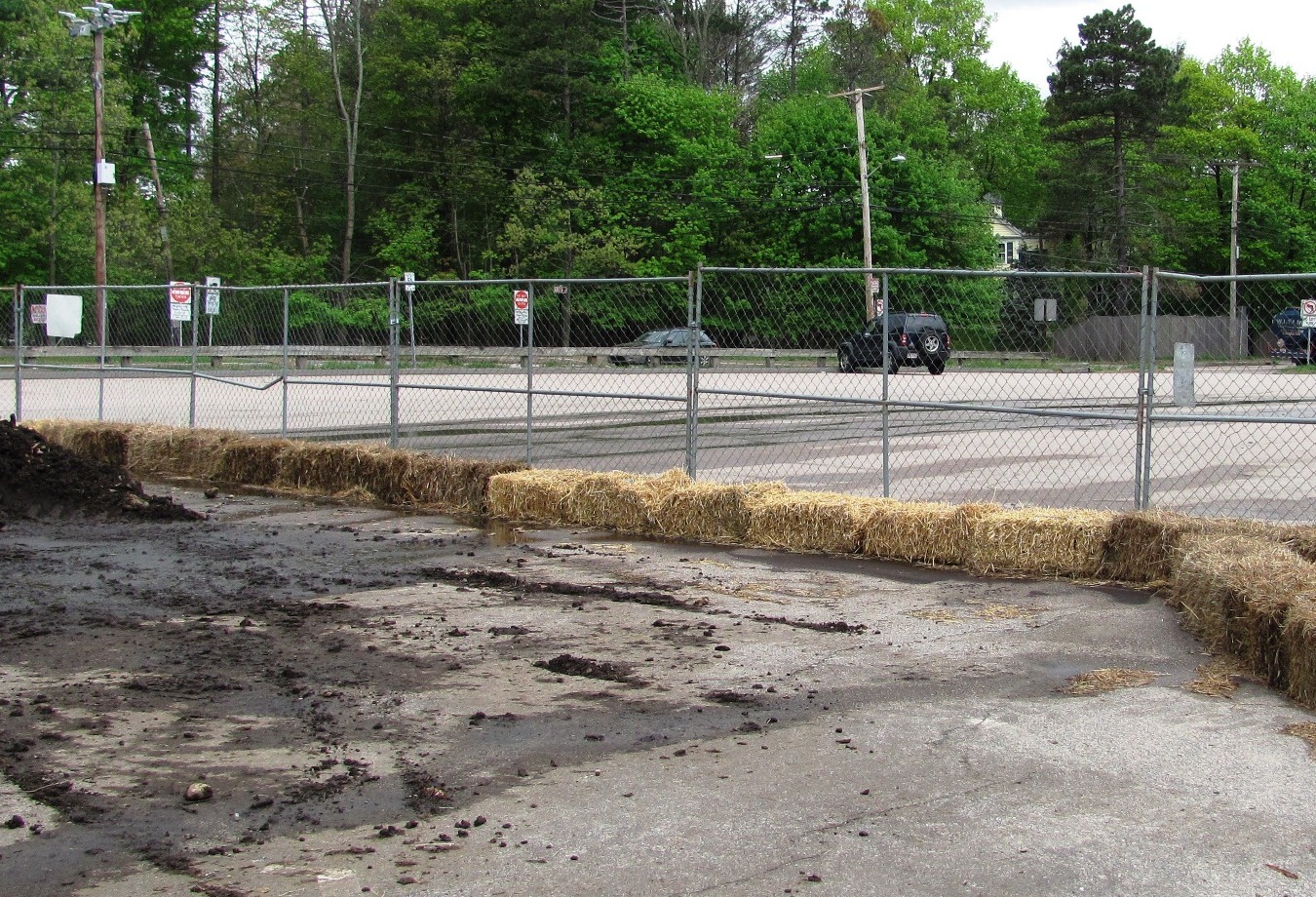Straw or Hay Bale Barrier

Definition
A temporary sediment barrier consisting of a row of entrenched and anchored straw bales. Used to intercept and detain small amounts of sediment from disturbed areas of limited extent to prevent sediment from leaving the site. Decreases the velocity of sheet flows and low-to-moderate level channel flows.
Where Practice Applies
- Downslope from disturbed areas subject to sheet and rill erosion.
- In minor swales where the maximum contributing drainage area is less than one acre.
- Where effectiveness is required for less than 3 months.
Advantages
When properly used, straw bale barriers are an inexpensive method of sediment control.
Disadvantages/Problems
- Straw bale barriers are easy to misuse. They can become contributors to a sediment problem instead of a solution unless properly located and maintained.
- It is difficult to tell if bales are securely seated and snug against each other.
Planning Considerations
- Straw or hay bale barriers are used similarly to sediment fence barriers; specifically where the area below the barrier is undisturbed and vegetated. Bale barriers require more maintenance than silt fence barriers and permeability through the bales is slower than sediment fence.
- Bales should be located where they will trap sediment; that is, where there will be contributing runoff. Bales located along the top of a ridge serve no useful purpose, except to mark limits of a construction area. Straw or hay bales located at the upper end of a drainage area perform no sediment-collecting function.
Installation
Maximum recommended slope lengths upslope from straw or hay bale barriers are as follows:
| Percent Slope | Maximum slope length (feet) |
| 1 | 180 |
| 4 | 100 |
| 9 | 60 |
| 14 | 40 |
| 18 | 30 |
| 30 | 20 |
| (Based on providing storage for 1.0 inch of runoff.) |
- Bales should be placed in a single row, lengthwise on the contour, with ends of adjacent bales tightly abutting one another.
- All bales should be either wire-bound or string-tied. Straw bales should be installed so that bindings are oriented around the sides rather than along the tops and bottoms of the bales in order to prevent deterioration of the bindings.
- The barrier should be entrenched and backfilled. A trench should be excavated the width of a bale and the length of the proposed barrier to a minimum depth of 4 inches. The trench must be deep enough to remove all grass and other material which might allow underflow. After the bales are staked and chinked (filled by wedging),the excavated soil should be backfilled against the barrier. Backfill soil should conform to the ground level on the downhill side and should be built up to 4 inches against the uphill side of the barrier.
- Each bale should be securely anchored by at least 2 stakes or re-bars driven through the bale. The first stake in each bale should be driven toward the previously laid bale to force the bales together. Stakes or re-bars should be driven deep enough into the ground to securely anchor the bales. For safety reasons, stakes should not extend above the bales but should be driven in flush with the top of the bale.
- The gaps between the bales should be chinked (filled by wedging) with straw to prevent water from escaping between the bales. Loose straw scattered over the area immediately uphill from a straw bale barrier tends to increase barrier efficiency. Wedging must be done carefully in order not to separate the bales.
- Straw bale barriers should be removed when they have served their usefulness, but not before the upslope areas have been permanently stabilized.
- When used in a swale, the barrier should be extended to such a length that the bottoms of the end bales are higher in elevation than the top of the lowest middle bale to assure that sediment-laden runoff will flow either through or over the barrier but not around it.
Common Trouble Points
- Improper use: Straw bale barriers have been used in streams and drainageways where high water velocities and volumes have destroyed or impaired their effectiveness.
- Improper placement and installation: Staking the bales directly to the ground with no soil seal or entrenchment allows undercutting and end flow. This has resulted in additions to, rather than removal of, sediment from runoff waters.
- Inadequate maintenance: Trapping efficiencies of carefully installed straw bale barriers on one project dropped from 57 percent to 16 percent in one month due to lack of maintenance.
Maintenance
- Straw bale barriers should be inspected immediately after each runoff-producing rainfall and at least daily during prolonged rainfall.
- Close attention should be paid to the repair of damaged bales, undercutting beneath bales, and flow around the ends of the bales.
- Necessary repairs to barriers or replacement of bales should be accomplished promptly.
- Sediment deposits should be checked after each runoff-producing rainfall. They must be removed when the level of deposition reaches approximately one-half the height of the barrier.
- Any sediment deposits remaining in place after the straw bale barrier is no longer required should be dressed to conform to the existing grade, prepared and seeded.
References
Minnick, E.L., and H.T. Marshall, Stormwater Management and Erosion County Conservation District, August 1992.
Washington State Department of Ecology ,Stormwater Management Manual for the Puget Sound Basin, Olympia,WA,February,1992.
Pennsylvania, Commonwealth of, Bureau of Soil and Water Conservation, Erosion and Sediment Pollution Control Program Manual, Harrisburg, PA, April, 1990.